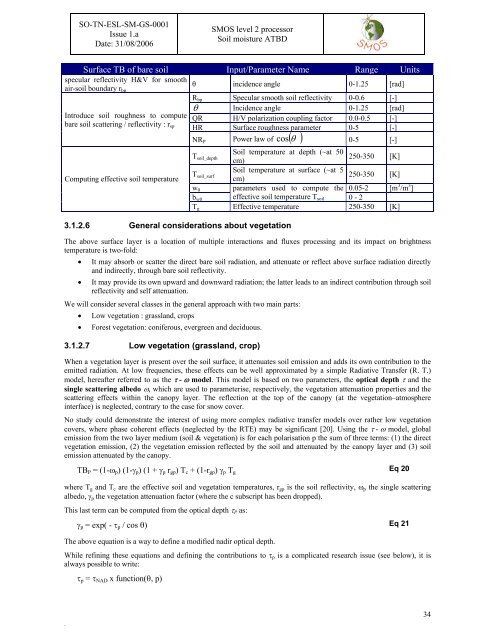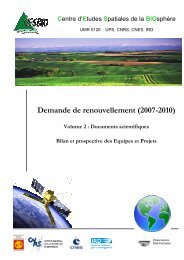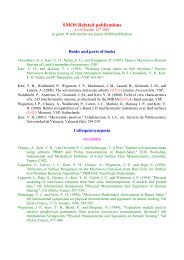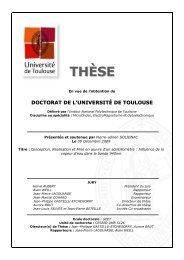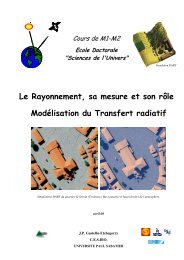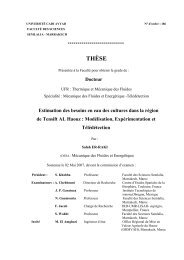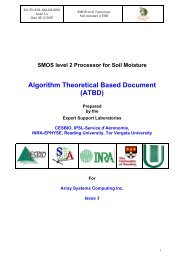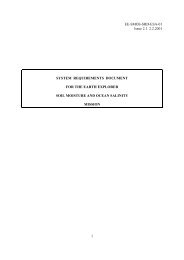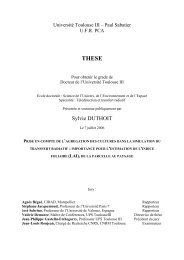Algorithm Theoretical Based Document (ATBD) - CESBIO
Algorithm Theoretical Based Document (ATBD) - CESBIO
Algorithm Theoretical Based Document (ATBD) - CESBIO
You also want an ePaper? Increase the reach of your titles
YUMPU automatically turns print PDFs into web optimized ePapers that Google loves.
SO-TN-ESL-SM-GS-0001<br />
Issue 1.a<br />
Date: 31/08/2006<br />
SMOS level 2 processor<br />
Soil moisture <strong>ATBD</strong><br />
Surface TB of bare soil Input/Parameter Name Range Units<br />
specular reflectivity H&V for smooth<br />
θ<br />
air-soil boundary r bp<br />
incidence angle 0-1.25 [rad]<br />
R bp Specular smooth soil reflectivity 0-0.6 [-]<br />
Introduce soil roughness to compute<br />
bare soil scattering / reflectivity : r sp<br />
Computing effective soil temperature<br />
θ Incidence angle 0-1.25 [rad]<br />
QR H/V polarization coupling factor 0.0-0.5 [-]<br />
HR Surface roughness parameter 0-5 [-]<br />
cos θ<br />
0-5 [-]<br />
NR P Power law of ( )<br />
3.1.2.6 General considerations about vegetation<br />
Soil temperature at depth (~at 50<br />
T soil_depth 250-350<br />
cm)<br />
[K]<br />
Soil temperature at surface (~at 5<br />
T soil_surf 250-350<br />
cm)<br />
[K]<br />
w 0 parameters used to compute the 0.05-2 [m 3 /m 3 ]<br />
b w0 effective soil temperature T soil 0 - 2<br />
T g Effective temperature 250-350 [K]<br />
The above surface layer is a location of multiple interactions and fluxes processing and its impact on brightness<br />
temperature is two-fold:<br />
• It may absorb or scatter the direct bare soil radiation, and attenuate or reflect above surface radiation directly<br />
and indirectly, through bare soil reflectivity.<br />
• It may provide its own upward and downward radiation; the latter leads to an indirect contribution through soil<br />
reflectivity and self attenuation.<br />
We will consider several classes in the general approach with two main parts:<br />
• Low vegetation : grassland, crops<br />
• Forest vegetation: coniferous, evergreen and deciduous.<br />
3.1.2.7 Low vegetation (grassland, crop)<br />
When a vegetation layer is present over the soil surface, it attenuates soil emission and adds its own contribution to the<br />
emitted radiation. At low frequencies, these effects can be well approximated by a simple Radiative Transfer (R. T.)<br />
model, hereafter referred to as the τ - ω model. This model is based on two parameters, the optical depth τ and the<br />
single scattering albedo ω, which are used to parameterise, respectively, the vegetation attenuation properties and the<br />
scattering effects within the canopy layer. The reflection at the top of the canopy (at the vegetation–atmosphere<br />
interface) is neglected, contrary to the case for snow cover.<br />
No study could demonstrate the interest of using more complex radiative transfer models over rather low vegetation<br />
covers, where phase coherent effects (neglected by the RTE) may be significant [20]. Using the τ - ω model, global<br />
emission from the two layer medium (soil & vegetation) is for each polarisation p the sum of three terms: (1) the direct<br />
vegetation emission, (2) the vegetation emission reflected by the soil and attenuated by the canopy layer and (3) soil<br />
emission attenuated by the canopy.<br />
TB P = (1-ω p ) (1-γ p ) (1 + γ p r gp ) T c + (1-r gp ) γ p T g<br />
Eq 20<br />
where T g and T c are the effective soil and vegetation temperatures, r gp is the soil reflectivity, ω p the single scattering<br />
albedo, γ p the vegetation attenuation factor (where the c subscript has been dropped).<br />
This last term can be computed from the optical depth τ P as:<br />
γ p = exp( - τ p / cos θ) Eq 21<br />
The above equation is a way to define a modified nadir optical depth.<br />
While refining these equations and defining the contributions to τ p is a complicated research issue (see below), it is<br />
always possible to write:<br />
τ p = τ NAD x function(θ, p)<br />
.<br />
34


